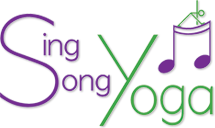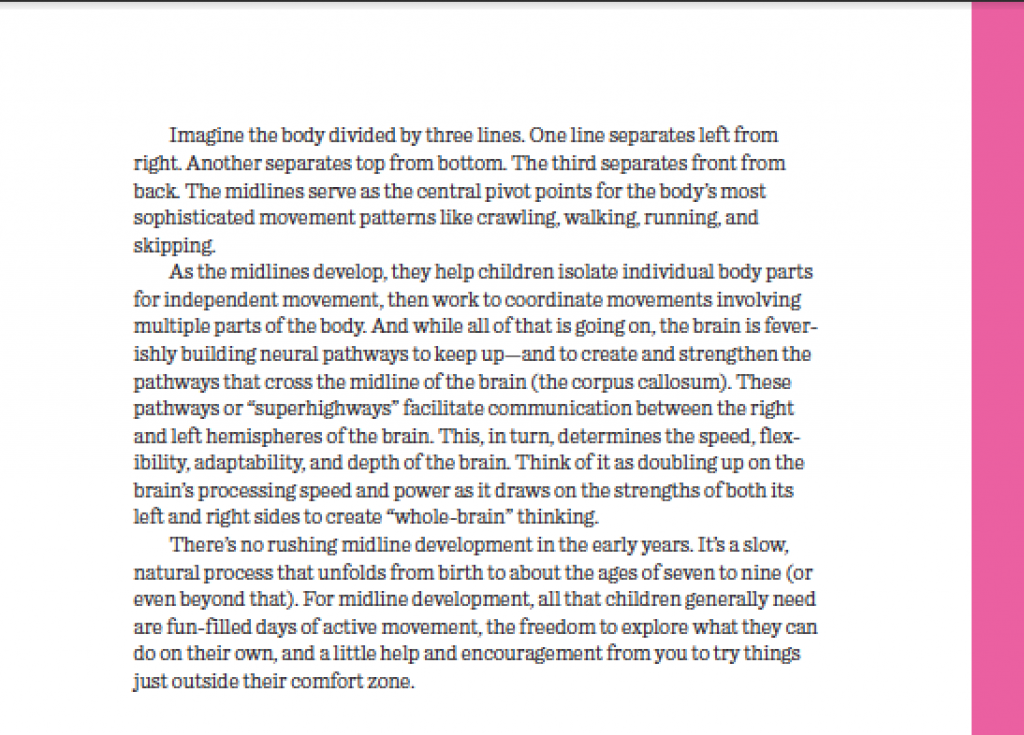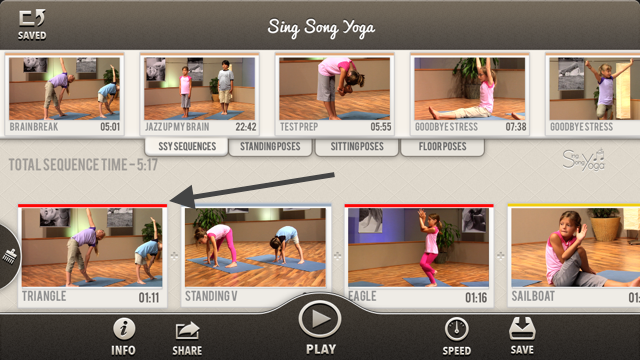Archive for the ‘Yoga in Schools’ Category
Crossing the Midline and Kids Yoga
Do you ever wonder why small children seem to lack coordination and tend to perform tasks slowly and somewhat clumsily? This is due to the fact that they are in the process of building neural networks – “roads” – in the brain.
You have likely heard of the terms cross-lateral movements or crossing the midline. The midlines are invisible lines dividing the body in half. When a leg or an arm from one half of the body crosses over to the other half of the body this is crossing the midline. This helps the brain communicate in greater depth by connecting both halves of the brain via the network of fibers, called the corpus callosum. This integration of the two sides of the brain determines the speed, flexibility, adaptability and depth of the brain’s thinking. When children are allowed to play freely over the years of childhood, they naturally cross these midlines just by being kids and playing in limitless ways.
Sometimes, however, children will show up to school without having had many of the necessary experiences for this to have occurred with the necessary repetition. When the midlines aren’t fully developed, cross-lateral movements might feel unnatural to a child. Educational researchers, educators, occupational and physical therapists have come up with activities to attempt to make up for lost time, so to speak. By getting children to move in specific ways within deliberate activities it can make midline crossing a regular occurrence to help achieve the repetition necessary to help build these roads in the brain. The handout below says “Think of it as doubling up on the brain’s processing speed and power as it draws on the strengths of both the left and right sides to create ‘whole-brain’ thinking.” Authors of A Moving Child is a Learning Child say that crossing the midline not only streamlines movement, it supersizes those superhighways across the corpus callosum. As such it plays a critical role in preparing children’s brains for formal learning.
Kids’ yoga is one of the many activites that can provide cross-lateral experiences for children. And if done regularly, along with other rhythm and movement activities, it might assist in building the brain for optimal development.
The handout below explains midlines in a new way for me. Prior to this learning I only divided the body in two halves, the left and right. But this author divides the body in two additional directions: the top and bottom and the front and back, thus making it midlines – plural. This opens the doorway to many more physical movements meeting the requirements of cross-lateral movements and is worth exploring further. I always love learning new things!
For some occupational therapy activities for crossing the midline see OT Mom Learning Activities.
Thank you to Free Spirit Publishing and authors of A Moving Child is a Learning Child, Gill Connell and Cheryl McCarthy, for allowing me to share this handout through Learners’ Edge.

Related Posts:
Top 6 Yoga Poses for Toddlers “A few months ago a parent asked how she could best do yoga with her one-year-old daughter…”
Kids Yoga App – Create Your Own Balancing Sequence Effortlessly create a balancing sequence with a few taps of this kids yoga iOS app.
Top 5 Tips to Help Kids Yoga Balance: Kid Twitter Question Answered A kid question answered: “Do you have any tips to help us balance better?”
Getting Kids Ready to Write: Yoga in Schools A teacher question answered: “I was wondering the best combinations [of poses] to use [with my students] for getting ready to write.”
Twitter Leads to Most Rewarding Visit Imaginable Sing Song Yoga founder does yoga with students she connected with on Twitter.
For more info: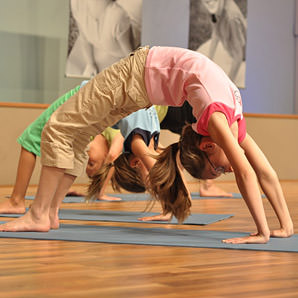
Sing Song Yoga® Kids’ Yoga App
Sing Song Yoga® kids’ yoga DVD
Sing Song Yoga® school program
This entry was posted on Monday, March 30th, 2015.
Posted in Benefits of Yoga, Education, Parenting, Yoga in Schools.
Tagged: children, cross-lateral activities, cross-lateral moments, crossing the midline, crossing the midlines, early childhood, early childhood activities, kid yoga, kids yoga, kids yoga benefits, midlines development, physical activities for toddlers, sing song yoga, yoga for kids, yoga in schools, yoga in the classroom
Yoga in Schools: Kids and Teachers Talk Kids Yoga.
A quick peek into what kids and teachers are saying about using the Sing Song Yoga app in the classroom. Kids yoga in schools explored… Highlights from the video clip:
Tell us about Sing Song Yoga®
What I would tell other kids about Sing Song Yoga is that you have to try it because it calms you before, if you do Daily Five in your classroom or writing. ~ first grader, MI
It all started with a simple challenge from our movement specialist in the district to say we’ve got to get our kids moving and that will increase the engagement. And I would say that Sing Song Yoga is our perfect answer to doing that. ~ Kristi Zoerhof, First Grade Teacher, MI
- “It keeps you strong and healthy and it really keeps you calm when you’re doing stuff.”
- “I would tell other kids that Sing Song Yoga is really fun.”
- “It is the funnest thing in the world.”
- “It gets your body moving and it makes you exercise.”
- “The app is my favorite because it is completely customizable. Whatever you have time to work with, whether its 5 minutes or 20, you can create yoga sequence videos for your kids to do. And it is actually a spot in our lesson plans that we have a spot for yoga.”
- “It’s really really fun and it’s relaxing.”
- “They love it. They look forward to it. They request it. And it is probably our most popular activity of the day.”
- “They should do it ’cause it’s really really fun.”
How does Sing Song Yoga® make you feel?
- “Sing Song Yoga makes me feel happy and calm.”
- “We find that we are more focused and our work time is more productive.”
- “I feel happy from yoga.”
- “Sing Song makes me feel happy.”
- “Sing Song Yoga makes me feel calm.”
- “It’s calming.”
- “I like crane pose because it makes me feel steady.”
- “Sing Song Yoga makes me feel happy.”
- “Sing Song Yoga makes me get happy and excited.”
What would you tell other teachers about Sing Song Yoga®?
- “I’m really sure that if your children do it, it’s going to be fantastic.”
- “Truly, every minute spent in Sing Song Yoga we have seen the rewards and the benefits in our classroom work. I would recommend it to every classroom teacher who wants to give their students a moment to have intentional movement breaks.”
- “The songs are really cool.”
- “You can see it on the iPad and you can see it on the screen.”
- “Try Sing Song Yoga. You will not be disappointed.”
- “I love Sing Song Yoga.”
Related Posts:
Getting Kids Ready to Write: Yoga in Schools A teacher question answered: “I was wondering the best combinations [of poses] to use [with my students] for getting ready to write.”
Twitter Leads to Most Rewarding Visit Imaginable Sing Song Yoga founder does yoga with students she connected with on Twitter.
Top 5 Tips to Help Kids Yoga Balance: Kid Twitter Question Answered A kid question answered: “Do you have any tips to help us balance better?”
At Sing Song Yoga we love tweeting with students about their yoga ideas, experiences and questions. We also love chatting with teachers! 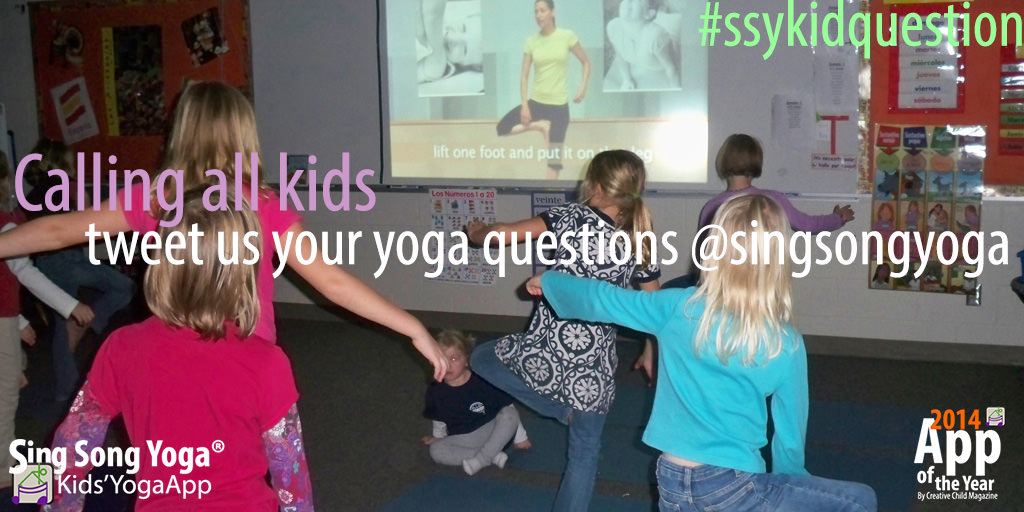
For more info:
Sing Song Yoga® Kids’ Yoga App
Sing Song Yoga® kids’ yoga DVD
Sing Song Yoga® school program
This entry was posted on Monday, February 9th, 2015.
Posted in Benefits of Yoga, Education, Sing Song Yoga, Yoga in Schools.
Tagged: app, brain breaks, children, childrens yoga, dvd, education, educators, kids yoga, kids yoga app, movement acivities, movement in the classroom, schools, sing song yoga, testimonial, yoga for children, yoga for kids, yoga in schools, yoga in the classroom
Kids Yoga in Schools: Getting First Graders Ready to Write
Sue, a first grade teacher from Michigan writes:
I was wondering the best combinations [of poses] to use [with my students] for getting ready to write.”
This is a great question! Yoga in schools can be a powerful resource for helping kids get ready to write, as well as do other school tasks. Kids’ Yoga is not going to take overly energetic children and mesmerize them into a state of conformity, but it can help a child transform their energy into a more usable form for accomplishing particular tasks. As teachers we occasionally need tiny reminders that children are not built to sit for long periods, and their squirminess might be good feedback to us that their bodies truly need to move in order for their brains to work most efficiently.
I know that, as an adult, when I rush around my world to run errands and then sit down in front of my computer to get some work done, it takes me a bit of time to refocus on my task at hand. Also, if I sit for an extended period of time I need to get up and move to focus most efficiently. Similarly, if a child is moving from one activity to the next without time to refocus with some deliberate guidance, or is sitting for extending periods of time without a chance for specific movement, then it’s likely that s/he won’t be able to give her best.
Yoga in schools can provide purposeful tools for helping children refocus. There’s much involved in how yoga can do this. However, simply put, focusing on one’s body to get into and hold a pose can help quiet the mind’s chatter, allowing more space for purposefully focused thought. And if the yoga movement itself is sufficiently involved it can fulfill the body’s need to move in order to stimulate the necessary systems for optimal learning.
In other words the physical yoga poses and the focus necessary to accomplish them work in tandem to help children refocus.
In addition to this, particular sequencing of poses also has the potential to calm the nervous system, which counters the stressors that physically shut down the brain for learning. The brain of a child who is in distress physically shuts down the networking necessary for learning. The brain of a relaxed child has much greater learning potential.
When thinking about yoga in schools it might be helpful to know that poses can be divided into three categories regarding their main effects on the nervous system:
- energizing poses (red – see arrow in pic below)
- calming poses (blue)
- neutral poses (yellow)
Poses can be sequenced to deliberately shoot for particular goals. For example, our Brain Break sequence was created to assist students in refocusing within their school day with the least number of poses necessary to accomplish the goal.
Brain Break Sequence includes:
- Triangle – general movement lengthening and strengthening the entire body
- Standing V – the inversion allows blood flow to the brain which may enhance mental functioning and forward bends calm the nervous system
- Eagle – crosses the mid-line helping the two halves of the brain communicate through the corpus callosum (helping to coordinate skills being carried out in different parts of the brain). Eagle also stimulates the vestibular system (balance), stimulating the brain for new learning
- Sailboat – crosses the mid-line and twisting allows for additional release of tension
Note below: the color coding above each pose in the app screenshot: red, blue and yellow represent energizing, calming and neutral poses respectively.
The Jazz up My Brain sequence within the Sing Song Yoga App is a longer version at 22 minutes. Teachers can throw poses out or add poses within the app within the sequence canvas and make it work for each situation. Sequences you create can be saved and named. And here’s another example of the app in use.
Thanks for stopping by! We intend to continue growing our posts dedicated to helping teachers enjoy the benefits of yoga in the classroom!
Until next time, Happy Teaching!
We would LOVE to hear from you – how you’re using yoga in schools or questions of how to begin. We are on Twitter @singsongyoga and Facebook and really look forward to connecting!
For more info:
Sing Song Yoga® kids’ yoga DVD
Sing Song Yoga® Kids’ Yoga App
Sing Song Yoga® school program
This entry was posted on Saturday, January 24th, 2015.
Posted in Benefits of Yoga, Education, Kid's Yoga Sequences, Sing Song Yoga, Yoga in Schools.
Tagged: app, children, childrens yoga, first graders, health, ipad app, iphone app, ipod touch app, kids, kids yoga, kids yoga app, kids yoga benefits, mindfulness, physical activities for toddlers, research, schools, sing song yoga, test prep, writing, yoga for kids, yoga in schools, yoga in the classroom, yoga poses
